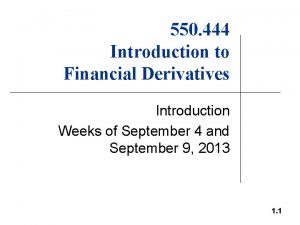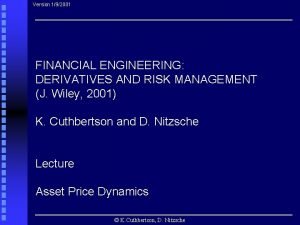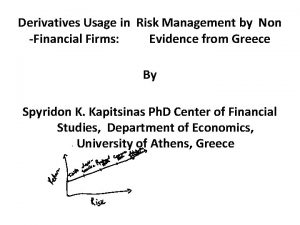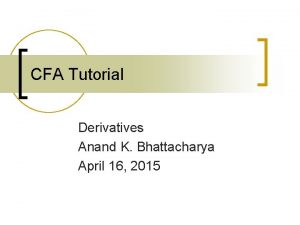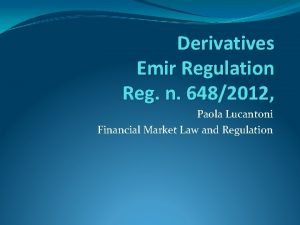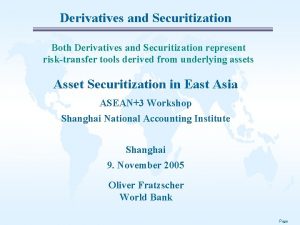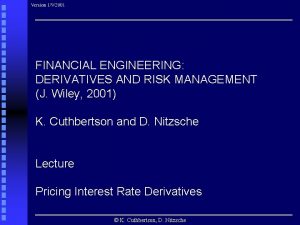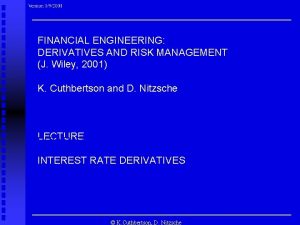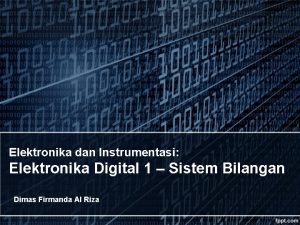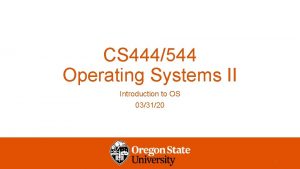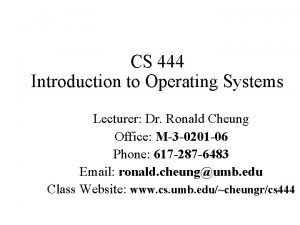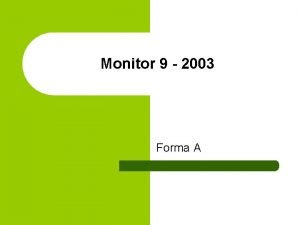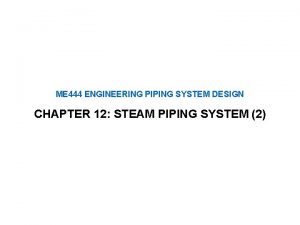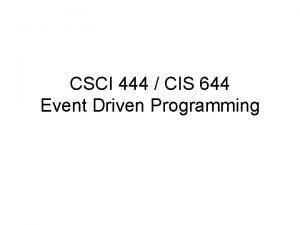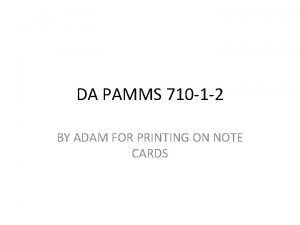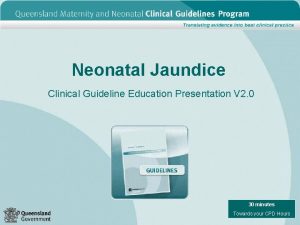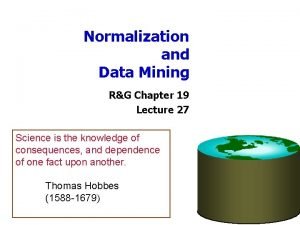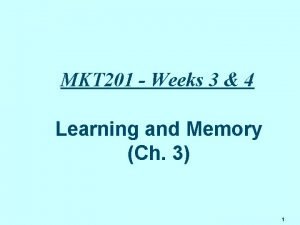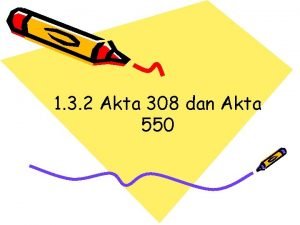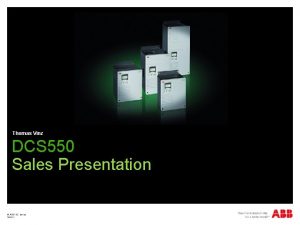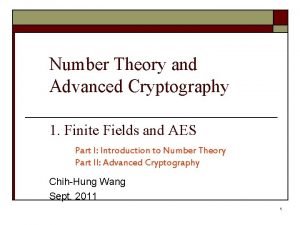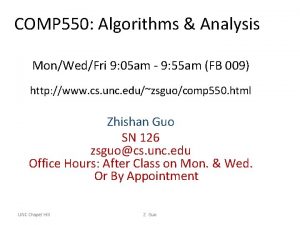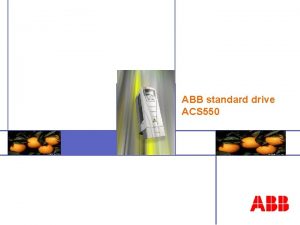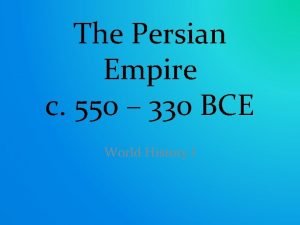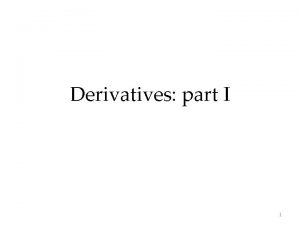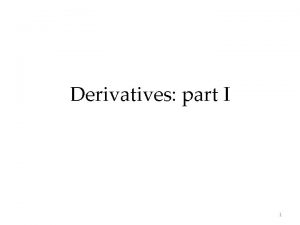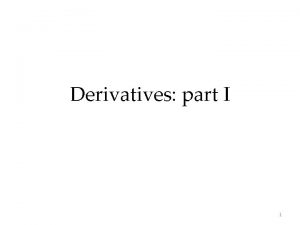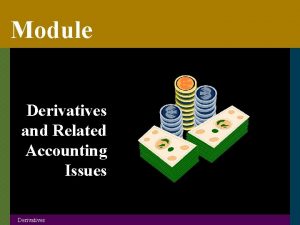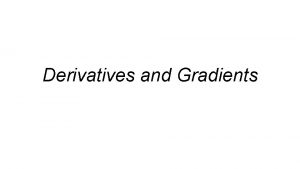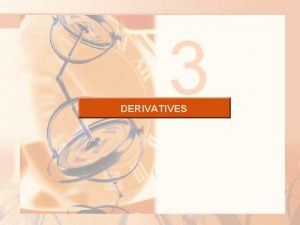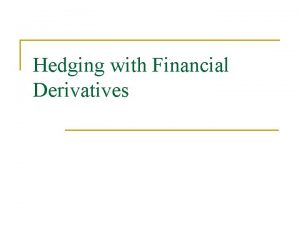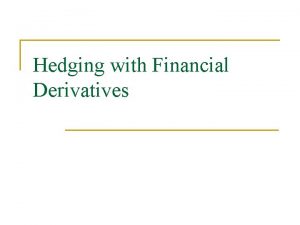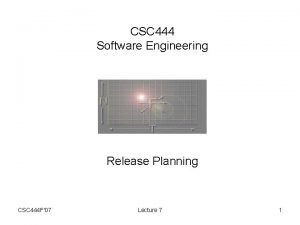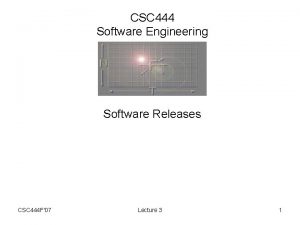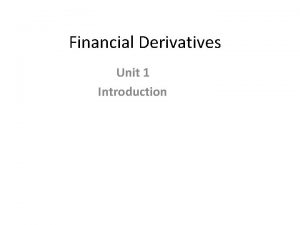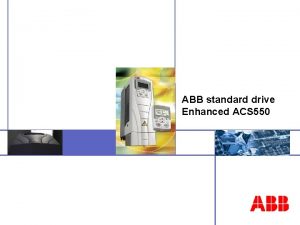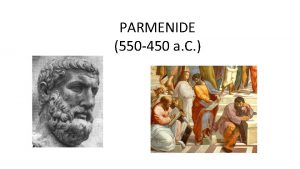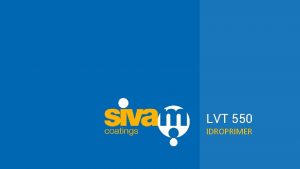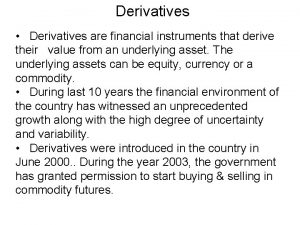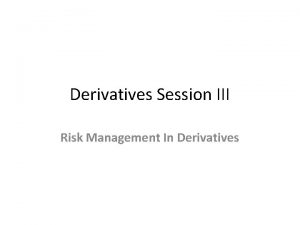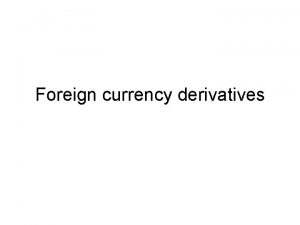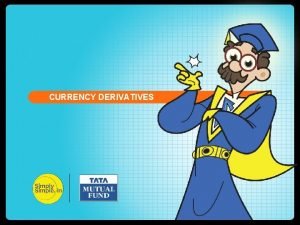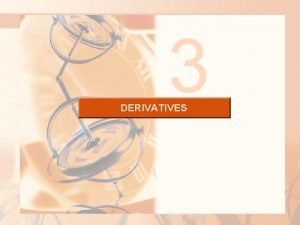550 444 Introduction to Financial Derivatives Introduction Weeks













































































- Slides: 77

550. 444 Introduction to Financial Derivatives Introduction Weeks of September 4 and September 9, 2013 1. 1

Principals l David R Audley, Ph. D. ; Sr. Lecturer in AMS l david. audley@jhu. edu l Office: WH 212 A; 410 -516 -7136 l Office Hours: 4: 30 – 5: 30 Monday l Teaching Assistant(s) l Huang, Qiushun (qhuang 13@jhu. edu) l Office Hours: Friday 4 pm – 6 pm l Ward, Brian (bward 16@jhu. edu) l Office Hours: Monday & Wednesday 2 pm – 3 pm 1. 2

Schedule l Lecture Encounters l Monday & Wednesday, 3: 00 - 4: 15 pm, l Mergenthaler 111 l Section 1: Friday 3: 00 - 3: 50 pm, Hodson 211 l Section 2: Thursday 3: 00 - 3: 50 pm, WH 304 1. 3

Protocol l Attendance l Lecture – Mandatory (default) for MSE Fin Math majors l Quizzes & Clickers l Section – Strongly Advised/Recommended l Assignments l Due as Scheduled (for full credit) l Must be handed in to avoid “incomplete” l Exceptions must be requested in advance 1. 4

Resources l Textbook l John C Hull: Options, Futures, and Other Derivatives, Prentice-Hall 2012 (8 e) l Recommended: Student Solutions Manual l On Reserve in Library l Text Resources l http: //www. rotman. utoronto. ca/~hull/ofod/Errata 8 e/index. html l http: //www. rotman. utoronto. ca/~hull/Technical. Notes/index. html 1. 5

Resources l Supplemental Material l As directed l AMS Website l http: //jesse. ams. jhu. edu/~daudley/444 l Additional Subject Material l Class Resources & Lecture Slides l Industry & Street “Research” (Optional) l Consult at your leisure/risk l Interest can generate Special Topics sessions l Blackboard 1. 6

Measures of Performance l l l Mid Term Exam (~1/3 of grade) Final Exam (~1/3 of grade) Home work as assigned and designated and Quizzes (~1/3 of grade) 1. 7

Assignment l Thru week of Sept 9 (Next Week) l Read: Hull Chapter 1 (Introduction) l Read: Hull Chapter 2 (Futures Markets) l Problems (Due September 16) l Chapter 1: 17, 18, 22, 23; 34, 35 § Chapter 1 (7 e): 17, 18, 22, 23; 30, 31 l Chapter 2: 15, 16, 21, 22; 30 § Chapter 2 (7 e): 15, 16, 21, 22; 27 1. 8

Assignment l For week of Sept 16 (in 2 Weeks) l Read: Hull Chapters 3 (Hedging with Futures) l Problems (Due September 23) l Chapter 3: 4, 7, 10, 17, 18, 20, 22; 26 § Chapter 3 (7 e): 4, 7, 10, 17, 18, 20, 22; 26 1. 9

Assets and Cash l Stock, Bond, Commodity, … (Assets) l Risk vs. Return (Expected Return) l Cash (or Currency) l Held, on Deposit or Borrowed l Terminology l Assets – things we “own” (long) l Liabilities – what we “owe” (short) 1. 10

How Things Work l l True Assets – A house, a company, oil, … Ownership rights, contracts, & other legal instruments which represent the true asset l For us, many are indistinguishable from the asset; are the asset l Provide properties that can be quantified, assigned, subordinated and made contingent l Can be modeled 1. 11

Who Makes it Work l Investment Banks: Capital Intermediation l Companies into Stock l Borrowings into Bonds l Broker-Dealers & Markets (Exchanges) l Create everything else l Facilitate transfer/exchange (trading) l l Investors Under the Watchful Eyes of Regulators, Professional Associations and the Rule of Law 1. 12

Creation & Exchange of Securities and Instruments Secondary Issues Collateral Create Securities Investment Banking New Issue Securities Make Markets Broker-Dealers & Exchanges Securities & Contracts Manage Invested Funds Institutional Investors 1. 13

Two Fundamental Ideas in Modeling LOAN FROM STANDPOINT OF LENDER l Cash Flow Repayment of Loan w/Interest at t 0+T Receive l Cash flow diagram l Receive vs. Pay over Time t, time Pay Amount of Loan, t 0 l Payoff Cashflow Gain l Payoff diagram S, Price l Gain vs. Loss against Price l Cashflows can depend on some other variable K Loss LONG STOCK AT PRICE K 1. 14

Real World Situation - Cash l l Japanese Bank; borrow US dollars (USD) to loan to its customers; term, 3 months Go to Euromarket where it might be able to get an Interbank Loan Receive (Borrow) T = 1/4 year Lt 0 = 3 month interest rate in effect at t 0 USD t 0 + T Borrow: USD Pay Back: USD x (1 + Lt 0 x T) t 0 Pay Back USD+Lt 0 x(. 25)x. USD 1. 15

Real World Situation - Cash l l What if Bank did not have credit line? Could perform the same transaction as a Synthetic in the FX and domestic Yen mkt l Borrow Yen in local mkt for term T, at L(t 0, Y) l Sell Yen and buy USD in spot FX mkt at e(t 0, Y) l Finally, the bank buys Yen and sells USD in the forward FX market for delivery at t 0+T 1. 16

Real World Situation - Cash l Cash Flows are Additive Borrow Y for T Y USD Yx(1+L(t 0, Y)x. T) + Buy USD sell Y at e(t 0, Y) Y = e(t 0, Y) x USD Y + Yx(1+L(t 0, Y)x. T) USDx(1+L(t 0, $)x. T) = USD Buy Y forward for t 0+T Y x (1 + L(t 0, Y)x. T) = f(t 0, T; Y) x USD 1 = USD x (1 + L(t 0, $) x T) USDx(1+L(t 0, $)x. T) t 0+T 1. 17

Real World Situation - Cash l What’s the difference; what’s interesting l International Banks have credit risk in the USD loan l For the synthetic, the International Bank exposure is in the forward contract only l No principal risk l Yen loan default is a domestic issue (central bank) l The synthetic can be used to price the derivative, excredit risk (what’s the derivative in this example? ) l Each side could be the other’s hedge l Different markets involve many legal & regulatory differences 1. 18

Real World Situation - Tax l Situation: l In Sept ‘ 02, investor bought asset S, S 0=$100 l EOM Nov, asset target reached at $150 (sell) l Sale yields gain of $50 (taxable) l Wash-Sale Rule prohibits: l Sell winner at $50 gain l Sell another asset, Z that’s down $50 to offset gain l Buy asset Z back next day as investor still likes it l Prohibited since trade is intentionally washing gain 1. 19

Real World Situation - Tax l l Alternative Synthetic using Options Call Option (Strike = S 0) § Long has right to buy underlying at pre-specified price, S 0 § Short has obligation to deliver underlying at that price l Expiration Payoff Chart + + S - S 0 For the LONG S 0 S For the SHORT 1. 20

Real World Situation - Tax l Put Option (Struck at S 0) § Long has right to sell underlying at pre-specified price, S 0 § Short has obligation to accept delivery of underlying at S 0 l Expiration Payoff Chart + + S - S 0 For the LONG S 0 S For the SHORT 1. 21

Real World Situation - Tax l Consider the Synthetic (to offset 50 gain) l Buy another Z asset at 50 in Nov (11/26/02) l Sell an at-the-money call on Z l Strike, Z 0 = 50 l Expiration >= 31 days later, but in 2002 (12/30/02) l Buy an at-the-money put on Z (same expiry) l At expiration, sell the Z asset or deliver into Call 1. 22

Real World Situation - Tax l Payoff Charts for the Synthetic + 50 Short Call Price at the expiration of the options, Ze Z If Ze > 50: • Short Call looses money as short has to deliver Z for 50 • Long Put is worthless Z If Ze < 50: • Short Call is worthless • Long Put gains as the long can sell Z for 50 Z In either case the investor has locked in the 50 price for the stock 1. 23 bought at 100 (FIFO) + 50 Long Put + Synthetic Short in Z - 50

Real World Situation - Tax l The timing issue is important l According to US Tax law, wash sale rules apply if the investor acquires or sells a substantially identical property within a 31 -day period l In the synthetic strategy, the second Z is purchased on 11/20; while the options expire on 12/30 when the first Z is sold (and the tax loss is “booked” – FIFO accounting) 1. 24

Real World Examples – Consequences & Implications l l l Strategies are Risk Free and Zero Cost (aside from commissions and fees) We created a Synthetic (using Derivatives) and used it to provide a solution Finally, and most important, these examples display the crucial role Legal & Regulatory frameworks can play in engineering a financial strategy (its the environment) 1. 25

Two Points of View l l Manufacturer (Dealer) vs. User (Investor) Dealer’s View: there are two prices l A price he will buy from you (low) l A price he will sell to you (high) l It’s how the dealer makes money l Dealer never has money; not like an investor l Must find funding for any purchase l Place the cash from any sale l Leverage 1. 26

Two Points of View l Dealers prefer to work with instruments that have zero value at initiation (x bid/ask) l Likely more liquid l No principal risk l Regulators, Professional Organizations, and the Law are more important for market professionals than investors l Dealers vs. Investors 1. 27

The Nature of Derivatives A derivative is an instrument whose value depends on the values of other more basic underlying variables 1. 28

Examples of Derivatives • Futures Contracts • Forward Contracts • Swaps • Options 1. 29

Derivatives Markets l Exchange traded l Traditionally exchanges have used the openoutcry system, but increasingly they are switching to electronic trading l Contracts are standard; virtually no credit risk l Over-the-counter (OTC) l A computer- and telephone-linked network of dealers at financial institutions, corporations, and fund managers l Contracts can be non-standard and there is some (small) amount of credit risk 1. 30

Size of OTC and Exchange Markets Source: Bank for International Settlements. Chart shows total principal amounts for OTC market and value of underlying assets for exchange market 1. 31

Ways Derivatives are Used l l l To hedge risks To speculate (take a view on the future direction of the market) To lock in an arbitrage profit To change the nature of a liability To change the nature of an investment without incurring the costs of selling one portfolio and buying another 1. 32

Forward Price l l The forward price (for a contract) is the delivery price that would be applicable to a forward contract if were negotiated today (i. e. , the delivery price that would make the contract worth exactly zero) The forward price may be different for contracts of different maturities 1. 33

Terminology l l The party that has agreed to buy has what is termed a long position The party that has agreed to sell has what is termed a short position 1. 34

Example l l l On May 24, 2010 the treasurer of a corporation enters into a long forward contract to buy £ 1 million in six months at an exchange rate of 1. 4422 This obligates the corporation to pay $1, 442, 200 for £ 1 million on November 24, 2010 What are the possible outcomes? 1. 35

Profit (or Payoff) from a Long Forward Position Profit K Price of Underlying at Maturity, ST Payoff at T = ST – K 1. 36

Profit from a Short Forward Position Profit = Payoff at T = K - ST K Price of Underlying at Maturity, ST 1. 37

Foreign Exchange Quotes for GBP May 24, 2010 Spot Bid 1. 4407 Offer 1. 4411 1 -month forward 1. 4408 1. 4413 3 -month forward 1. 4410 1. 4415 6 -month forward 1. 4416 1. 4422 1. 38

Foreign Exchange Quotes for JPY Jan 22, 2007 (16: 23 EST) Spot Bid 121. 62 Offer 121. 63 1 -month forward 121. 08 121. 09 3 -month forward 120. 17 120. 18 6 -month forward 118. 75 118. 77 1. 39

1. Gold: An Arbitrage Opportunity? Suppose that: • The spot price of gold is US$900 • The 1 -year forward price of gold is US$1, 020 • The 1 -year US$ interest rate is 5% per annum Is there an arbitrage opportunity? 1. 40

2. Gold: Another Arbitrage Opportunity? Suppose that: • The spot price of gold is US$900 • The 1 -year forward price of gold is US$900 • The 1 -year US$ interest rate is 5% per annum Is there an arbitrage opportunity? 1. 41

The Forward Price of Gold – The Principal of Cash and Carry l l If the spot price of gold is S(t 0) and the forward price for a contract deliverable in T years is F(t 0, T), then Can borrow money, buy gold, and sell the commodity forward - where there should be no arbitrage: F(t 0, T) - S(t 0) x (1+r )T = 0 l l where r is the 1 -year money rate of interest to finance the gold carry trade. In our examples, S = 900, T = 1, and r =0. 05 so that F(t 0, T) = 900(1+0. 05) = 945 The no arbitrage 1 year forward price of gold is $945 1. 42

The Forward Price of Gold – The Principal of Cash and Carry l How does this come about? S(t 0) receive pay Borrow S(t 0) t 0 + S(t 0)x(1+r) Gold Buy Gold at S(t 0) + F(t 0) Sell Gold Forward at F(t 0) Gold = Own Deliver No Arbitrage condition says: Gold F(t 0) – S(t 0)x(1+r) = 0 1. 43

Gold Arbitrage? l The no arbitrage gold, 1 -year forward condition is F(t 0, T) - S(t 0) x (1+r )T = 0 l If 1 -year forward is $1020, then F(t 0, T) - S(t 0) x (1+r )T > 0 l so our strategy is to borrow money, buy gold, sell it forward, deliver gold, and pay off loan for a riskless profit of $75 If 1 -year forward is $900, then F(t 0, T) - S(t 0) x (1+r )T < 0 and if I own gold, I can sell it, deposit proceeds, buy forward, pay with the proceeds of the deposit and collect a riskless profit of $45 over the 1 -year period 1. 44

Futures Contracts l l l Agreement to buy or sell an asset for a certain price at a certain time Similar to forward contract Whereas a forward contract is traded OTC, a futures contract is traded on an exchange 1. 45

Futures Contracts l l Forward contracts are similar to futures except that they trade in the over-thecounter market Forward contracts are particularly popular on currencies and interest rates 1. 46

Exchanges Trading Futures l l l l Chicago Board of Trade (CME) Chicago Mercantile Exchange LIFFE (London) Eurex (Europe) BM&F (Sao Paulo, Brazil) TIFFE (Tokyo) and many more (see list at end of book) 1. 47

Examples of Futures Contracts Agreement to: l Buy 100 oz. of gold @ US$1080/oz. in December (NYMEX) l Sell £ 62, 500 @ 1. 4410 US$/£ in March (CME) l Sell 1, 000 bbl. of oil @ US$120/bbl. in April (NYMEX) 1. 48

Options A call option is an option to buy a certain asset by a certain date for a certain price (the strike price) l A put option is an option to sell a certain asset by a certain date for a certain price (the strike price) l 1. 49

American vs European Options l l An American style option can be exercised at any time during its life A European style option can be exercised only at maturity 1. 50

Intel Option Prices (Sept 12, 2006; Stock Price=19. 56) Strike Price Oct Call Jan Call Apr Call Oct Put Jan Put Apr Put 15. 00 4. 650 4. 950 5. 150 0. 025 0. 150 0. 275 17. 50 2. 300 2. 775 3. 150 0. 125 0. 475 0. 725 20. 00 0. 575 1. 175 1. 650 0. 875 1. 375 1. 700 22. 50 0. 075 0. 375 0. 725 2. 950 3. 100 3. 300 25. 00 0. 025 0. 125 0. 275 5. 450 1. 51

Exchanges Trading Options l l l l Chicago Board Options Exchange American Stock Exchange Philadelphia Stock Exchange Pacific Exchange LIFFE (London) Eurex (Europe) and many more (see list at end of book) 1. 52

Options vs Futures/Forwards l l A futures/forward contract gives the holder the obligation to buy or sell at a certain price An option gives the holder the right to buy or sell at a certain price 1. 53

Types of Traders • Hedgers • Speculators • Arbitrageurs Some of the largest trading losses in derivatives have occurred because individuals who had a mandate to be hedgers or arbitrageurs switched to being speculators (See, for example, Soc. Gen (Jerome Kerviel) in Business Snapshot 1. 3, page 17) 1. 54

Hedging Examples (pages 10 -12) l l A US company will pay £ 10 million for imports from Britain in 3 months and decides to hedge using a long position in a forward contract An investor owns 1, 000 Microsoft shares currently worth $28 per share. A two-month put option with a strike price of $27. 50 costs $1. The investor decides to hedge by buying 10 contracts 1. 55

Hedging Example l l A US company will pay £ 10 million for imports from Britain in 3 months and decides to hedge using a long position in a forward contract Possible strategies: l Buy £ now, deposit in bank, withdraw £ 10 million in 3 months, pay for imports l Buy £ 10 million forward in 3 months, deposit USD, use deposit proceeds to settle and pay for imports l Do nothing now and buy £ 10 million in the spot FX market in 3 months l l First 2 are riskless, third has currency risk. Which makes most sense? 1. 56

Value of Microsoft Shares with and without Hedging 1. 57

Speculation Example l l An investor with $2, 000 to invest feels that a stock price will increase over the next 2 months. The current stock price is $20 and the price of a 2 -month call option with a strike of 22. 50 is $1 What are the alternative strategies? Buy 100 shares or Buy 20 Calls (on 100 shares each) 1. 58

Arbitrage Example l l A stock price is quoted as £ 100 in London and $140 in New York The current exchange rate is 1. 4410 What is the arbitrage opportunity? Buy 100 shares in NY; sell 100 in London l = 100 [(1. 441 x 100) – 140] = 410 1. 59

Futures Contracts l l l Available on a wide range of underlyings Exchange traded Specifications need to be defined: l What can be delivered, l Where it can be delivered, & l When it can be delivered l Settled daily 1. 60

Forward Contracts vs Futures Contracts FORWARDS FUTURES Private contract between 2 parties Exchange traded Non-standard contract Standard contract Usually 1 specified delivery date Settled at end of contract Delivery or final cash settlement usually occurs Some credit risk Range of delivery dates Settled daily Contract usually closed out prior to maturity Virtually no credit risk 1. 61

Margins l A margin is cash or marketable securities deposited by an investor with the broker l Initial Margin l Maintenance Margin l l The balance in the margin account is adjusted to reflect daily settlement Margins minimize the possibility of a loss through a default on a contract 1. 62

Example: Futures Trade (page 27 -28) 1. 63

A Possible Outcome Table 2. 1, Page 28 1. 64

Other Key Points About Futures l l l They are settled daily Closing out a futures position involves entering into an offsetting trade Most contracts are closed out before maturity 1. 65

Collateralization in OTC Markets l l It is becoming increasingly common for contracts to be collateralized in OTC markets They are then similar to futures contracts in that they are settled regularly (e. g. every day or every week) 1. 66

Another Detail for Cash and Carry Arbitrage l Contract price changes with longer term l Higher or Lower l l To this point we have neglected storage cost Lets re-visit no-arbitrage equation F(t 0, T) - S(t 0) x [(1+r )T ] = Storage (T) l l l Storage costs ignored in earlier gold example No storage costs for FX Convenience Yield 1. 67

1. Oil: An Arbitrage Opportunity? Suppose that: - The spot price of oil is US$95 - The quoted 1 -year futures price of oil is US$125 - The 1 -year US$ interest rate is 5% per annum - The storage costs of oil are 2% per annum Is there an arbitrage opportunity? 1. 68

2. Oil: Another Arbitrage Opportunity? Suppose that: - The spot price of oil is US$95 - The quoted 1 -year futures price of oil is US$80 - The 1 -year US$ interest rate is 5% per annum - The storage costs of oil are 2% per annum Is there an arbitrage opportunity? 1. 69

Futures Prices for Gold on Jan 8, 2007: Prices Increase with Maturity Futures Price ($ per oz) 650 640 630 620 610 600 Jan-07 Contract Maturity Month Apr-07 Jul-07 Oct-07 Jan-08 1. 70

Futures Price (cents per lb) Futures Prices for Orange Juice on Jan 8, 2007: Prices Decrease with Maturity 210 205 200 195 190 185 180 175 170 Jan-07 Contract Maturity Month Mar-07 May-07 Jul-07 Sep-07 Nov-07 1. 71

Delivery l l If a futures contract is not closed out before maturity, it is usually settled by delivering the assets underlying the contract. When there alternatives about what is delivered, where it is delivered, and when it is delivered, the party with the short position chooses. A few contracts (for example, those on stock indices and Eurodollars) are settled in cash 1. 72

Some Terminology l l l Open interest: the total number of contracts outstanding l equal to number of long positions or number of short positions Settlement price: the price just before the final bell each day l used for the daily settlement process Volume of trading: the number of contracts traded in 1 day 1. 73

Convergence of Futures to Spot Futures Price Spot Price Futures Price Time (a) Time (b) 1. 74

Questions l l When a new trade is completed what are the possible effects on the open interest? Can the volume of trading in a day be greater than the open interest? 1. 75

Regulation of Futures l Regulation is designed to protect the public interest l CFTC – the Feds l Regulators try to prevent questionable trading practices by either individuals on the floor of the exchange or outside groups l NFA – the industry 1. 76

The End for Today l Questions? 1. 77
 550-444
550-444 Financial engineering derivatives and risk management
Financial engineering derivatives and risk management Non financial derivatives
Non financial derivatives St x
St x Paola lucantoni
Paola lucantoni Securitization
Securitization Financial engineering derivatives and risk management
Financial engineering derivatives and risk management Financial engineering derivatives and risk management
Financial engineering derivatives and risk management 444 5 lecke
444 5 lecke Arti dari 444 555 666 888 33 88
Arti dari 444 555 666 888 33 88 Cs 444 oregon state
Cs 444 oregon state Cs 444
Cs 444 Introduction to engineering in society
Introduction to engineering in society 444 ptt
444 ptt Ciferny sucet cisla 444
Ciferny sucet cisla 444 Lied 444
Lied 444 444
444 Jamil bin harun v yang kamsiah
Jamil bin harun v yang kamsiah 0 444 fração geratriz
0 444 fração geratriz Me 444
Me 444 -vertical
-vertical Pneumatic piping system design
Pneumatic piping system design Me 444
Me 444 N 444
N 444 444 outline
444 outline Karatay madrasa
Karatay madrasa 444 ptt
444 ptt Sprinkler pipe size chart
Sprinkler pipe size chart Luke triumphal entry
Luke triumphal entry Artaxerxes decree 445
Artaxerxes decree 445 Dd form 581
Dd form 581 Cmlxiv
Cmlxiv /mapi/emsmdb/
/mapi/emsmdb/ Names that rhyme with julie
Names that rhyme with julie Weeks of supply formula
Weeks of supply formula Weeks of supply formula
Weeks of supply formula 3 weeks pregnant ultrasound
3 weeks pregnant ultrasound Cough for 3 weeks
Cough for 3 weeks 5 to 6 weeks
5 to 6 weeks 4 weeks prior to christmas
4 weeks prior to christmas đầu ối phồng
đầu ối phồng Management of neonatal jaundice pdf
Management of neonatal jaundice pdf Gestational age in weeks
Gestational age in weeks This weeks lesson
This weeks lesson According to walter pauk, 10 weeks after lecture
According to walter pauk, 10 weeks after lecture Rolling rota
Rolling rota Each space
Each space Flocabul
Flocabul Mamidi tandra takes weeks of hard work
Mamidi tandra takes weeks of hard work 8 weeks embryo
8 weeks embryo Two week notice letter example
Two week notice letter example Fetus at 15 weeks pictures
Fetus at 15 weeks pictures 3 weeks from today
3 weeks from today Shannon weeks
Shannon weeks Mems microfluidics
Mems microfluidics Regolith
Regolith How many weeks
How many weeks 3rd 9 weeks exam review chemistry
3rd 9 weeks exam review chemistry 201 weeks
201 weeks 6 weeks of lent
6 weeks of lent 4 weeks before christmas
4 weeks before christmas 603 550 israelites
603 550 israelites Byzantine empire 550 ad
Byzantine empire 550 ad 550 poirier st coquitlam bc
550 poirier st coquitlam bc Akta tadika
Akta tadika Dcs 550
Dcs 550 Find multiplicative inverse of 550 in gf(1759)
Find multiplicative inverse of 550 in gf(1759) 649 en yakın onluğa yuvarlama
649 en yakın onluğa yuvarlama Toeic 550
Toeic 550 624 en numeros romanos
624 en numeros romanos Unc comp 550
Unc comp 550 Ach 550
Ach 550 5+5+5=550
5+5+5=550 Ahri
Ahri 320+550
320+550 550
550 550+330
550+330 Telit sat 550
Telit sat 550
